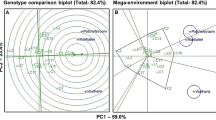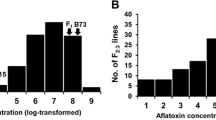Abstract
Preharvest aflatoxin (AF) contamination by Aspergillus flavus Link:Fr is one of the main limitations for maize (Zea mays, L.) production in the southern USA, causing enormous economic losses and posing a risk to animal and human health. The objectives of this study were (1) to estimate aflatoxin accumulation and expression of associated traits in quality protein maize (QPM) inbreds and their testcrosses, (2) to compute their repeatabilities and correlations, and (3) to study the relationship between inbred lines and their testcrosses for aflatoxin accumulation. Forty-eight inbreds and their testcrosses plus checks were grown in one and three locations in south and central Texas, respectively. Aflatoxin concentration was evaluated in the plants following inoculation with A. flavus. Average aflatoxin concentration overall for inbreds was 286.3 ng g−1, and for testcrosses 596.5 ng g−1 at Corpus Christi, TX, 325.1 ng g−1 at Weslaco, TX, and 105.1 ng g−1 at College Station, TX. Flinty orange inbreds developed from CIMMYT Population 69 were the least susceptible to aflatoxin accumulation in both inbreds and testcrosses at all locations. Repeatability for aflatoxin was 0.67 in inbreds at Weslaco, TX and 0.54 in testcrosses across locations. Aflatoxin in testcrosses was positively correlated both phenotycally and genotypically with endosperm texture and kernel integrity, and negatively correlated with grain yield and silking date. Less aflatoxin accumulation was associated with flinty endosperm texture, better kernel integrity, and later maturities. Association between the expression of traits in inbreds and aflatoxin in testcrosses was relatively high for endosperm texture (R 2 = 0.62), silking date (R 2 = 0.44), kernel integrity (R 2 = 0.39), and aflatoxin (R 2 = 0.60 for log ng g−1). It seems plausible to select for associated traits having high heritabilities and strong correlation with aflatoxin, in addition to low aflatoxin accumulation in inbreds and hybrids to reduce the risk of aflatoxin contamination.
Similar content being viewed by others
Abbreviations
- AF:
-
aflatoxin
- QPM:
-
Quality Protein Maize
- IL:
-
inbred line
- TC:
-
testcrosses
References
Baker RJ (1986) Selection indices in plant breeding. CRC Press, Boca Raton, FL
Betrán FJ, Bänziger M, Edmeades G, Beck D (1997) Relationship between line and topcross performance under drought and non-stressed conditions in tropical maize. In: Edmeades GO, Bänziger M, Mickelson HR, Peña-Valdivia CB (eds) Developing drought and Low-N tolerant maize. Proceedings of a Symposium, March 25–29, 1996. CIMMYT, El Batan, México
Betrán FJ, Isakeit T, Odvody G (2002a) Aflatoxin accumulation of white and yellow maize inbreds in diallel crosses. Crop Sci 42:1894–1901
Betrán FJ, Isakeit T, Odvody G, Mayfield K (2002b) Maize germplasm evaluation for aflatoxin resistance in Texas. Mycopathologia 155:81
Betrán FJ, Isakeit T (2002) Aflatoxin contamination in maize hybrids with different maturities. Agron J 96:565–570
Betrán FJ, Beck D, Bänziger M, Edmeades GO (2003a) Genetic analysis of grain yield in inbreds and hybrids under stress and non-stress environments in tropical maize. Crop Sci 43:807–817
Betrán FJ, Bockholt A, Fojt III F, Waniska R (2003b) Registration of Tx802 Maize parental line. Crop Sci 43:1891–1892
Betrán, FJ, Isakeit T, Odvody G, Mayfield K (2005) Breeding Maize to reduce preharvest aflatoxin contamination. In: Abbas H (ed) Aflatoxin and food safety. Marcel Dekker, Inc., New York
Bhatnagar S, Betrán FJ, Transue D (2003) Aflatoxin resistance of subtropical/tropical quality protein maize hybrids in Texas. Maydica 48:113–124
Brown R, Bhatnagar D, Cleveland TE, Cary JW (1998) Recent advances in preharvest prevention of mycotoxin contamination. In: Sinha KK, Bhatnagar D (eds) Mycotoxins in agriculture and food safety. Marcel Dekker, Inc., New York, pp 351–379
Brown RL, Cleveland TE, Chen Z, Gembeh SV, Menkir A, Moore S, Jeffers D, Damann KE, Bhatnagar D (2001) The identification of maize kernel resistance traits through comparative evaluation of aflatoxin-resistant with susceptible germplasm. Mycopathologia 155:77
Campbell KW, White DG (1995) Evaluation of maize genotypes for resistance to Aspergillus ear rot, kernel infection, and aflatoxin production. Plant Dis 79:1039–1042
Castegnaro M, McGregor D (1998) Carcinogenic risk assessment of mycotoxins. Rev Med Vet 149:671–678
Casler MD (1982) Genotype × environment interaction bias to parent-offspring regression heritability. Crop Sci 22:540–542
Falconer DS, Mackay TFC (1996) Introduction to quantitative genetics, 4th edn. Longman, Essex, England
Fehr W (1987) Principles of cultivar development, vol 1. Macmillan Publishing Co., New York
Gilmour AR, Cullis BR, Verbyla AP (1997) Accounting for natural and extraneous variation in the analysis of field experiments. J Agric Biol Env Stat 2:269–293
Guo BZ, Russin JS, Cleveland TE, Brown RL, Widstrom NW (1995) Wax and cutin layers in maize kernels associated with resistance to aflatoxin production by Aspergillus flavus. J Food Prot 58:296–300
Guo BZ, Widstrom NW, Holbrook CC, Lee RD, Lynch RE (2001) Molecular genetic analysis of resistance mechanisms to aflatoxin formation in maize and peanut. Mycopathologia 155:78
Hallauer AR, Miranda JB, Fo (1988) Quantitative genetics in maize breeding, 2nd edn. Iowa State Univ. Press, Ames
Holland, JB, Nyquist WE, Cervantes-Martinez CT (2003) Estimating and interpreting heritability for plant breeding: an update. Plant Breed Rev. 22:9–112. John Wiley & Sons, Inc., New York, NY
Holland JB (2006) Estimating genotypic correlations and their standard errors using multivariate restricted maximum likelihood estimation with SAS Proc MIXED. Crop Sci 46:642–654
Lin CY (1978) Index selection for genetic improvement of quantitative characterers. Theor Appl Genet 52:49–56
McMillian WW, Wilson DM, Widstrom NW (1985) Aflatoxin contamination of preharvest maize in Georgia: a six-year study of insect damage and visible Aspergillus flavus. J Environ Qual 14:200–202
Nielsen, K, Kirst M, Boston RS, Payne G (2002) Protection of kernels from infection by Aspergillus flavus is decreased in Opaque-2 mutants of maize. In: Proceedings of the 15th aflatoxin elimination workshop, October 2002, San Antonio, TX
Odvody GN, Spencer N, Remmers J (1997) A description of silk cut, a stress-related loss of kernel integrity in preharvest maize. Plant Dis 81:439–444
Patterson HD, Williams ER (1976) A new class of resolvable incomplete block designs. Biometrika 63:83–89
Payne GA (1992) Aflatoxin in maize. Crit Rev Plant Sci 10:423–440
SAS Institute (1997) SAS proprietary software release 6.12. SAS Inst., Inc., Cary, NC
Scott GE, Zummo N (1988) Sources of resistance in maize to kernel infection by Aspergillus flavus in the field. Crop Sci 28:504–507
Scott GE, Zummo N (1992) Registration of Mp420 germplasm line of maize. Crop Sci 32:1296
Smith OS (1986) Covariance between line per se and testcross performance. Crop Sci 26:540–543
Vasal SK (2001) High quality protein maize. In: Hallauer AR (eds) Specialty maizes. CRC, Boca Raton, FL, USA, pp 85–129
Widstrom NW, Wilson DM, McMillian WW (1984) Ear resistance of maize inbreds to field aflatoxin contamination. Crop Sci 24:1155–1157
Widstrom NW (1987) Breeding strategies to control aflatoxin contamination of maize through host plant resistance. In: Zuber MS, Lillehoj EB, Renfro BL (eds) Aflatoxin in maize: a proceedings of the workshop. CIMMYT, Mexico, D.F., pp 212–220
Widstrom NW, McMillian WW, Wilson DM (1987) Segregation for resistance to aflatoxin contamination among seeds on an ear of hybrid maize. Crop Sci 27:961–963
Widstrom NW (1996) The aflatoxin problem with maize grain. Adv Agr 56:2129–2280
Windham GL, Williams WP, Davis FM (1999) Effects of the southwestern maize borer on Aspergillus flavus kernel infection and aflatoxin accumulation in maize hybrids. Plant Dis 83:535–540
Acknowledgements
We thank Jeff Remmers, Carlos Gonzalez, Charles Chilcutt, Beto Garza, John Drawe, Marvin Miller, and Eugene Jimenez for their assistance conducting the field trials, processing the plot samples, conducting insect injury ratings and analyzing aflatoxin content. This research was partly funded by an USDA aflatoxin competitive grant and the Texas Corn Producers Board.
Author information
Authors and Affiliations
Corresponding author
Rights and permissions
About this article
Cite this article
Betrán, F.J., Bhatnagar, S., Isakeit, T. et al. Aflatoxin Accumulation and Associated Traits in QPM Maize Inbreds and their Testcrosses. Euphytica 152, 247–257 (2006). https://doi.org/10.1007/s10681-006-9207-3
Received:
Accepted:
Published:
Issue Date:
DOI: https://doi.org/10.1007/s10681-006-9207-3




